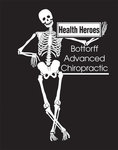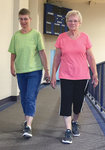

What would your fitness be, or more importantly what would the quality of your life be if you had a difficult time walking across the room because your balance was diminished? We continue last week’s article on balance.
Last week, I consulted local physiotherapist Andrea Russell who broke down balance evaluation into three parts: visual, somatosensory or the joints and surrounding tissue and vestibular system, or the center for balance in the brain. Normally, Andrea is assessing lower level functioning persons to create a treatment plan to restore a higher quality of life by improving stability and mobility.
Let’s get visual out of the way. A tremendous number of injuries come from falling at night because darkness can cause disorientation or hide a sleeping pet to be tripped on. Turn on the light. Better a grouchy spouse than a broken hip. There is much more on the field of vision and a visit to the physiotherapist can be helpful in assessing this.
The nervous system is a vast communication set up. The brain is simplistically a big computer. Nerves receive and carry information to the brain. When it comes to motion and balance, the nerves in and around the joints create a constant awareness of where the body is in space. You then tell the brain to make the body move in certain directions. Your brain sets up a massively complex operation to create movement and correct imbalance as it occurs. Increasingly sedentary lifestyles allow balance to degrade and are often chalked up to old age. The loss of balance leads to a fear of falling and a hesitancy to be active. The condition builds on itself.
Disruption of the balance communications can also occur from a sudden injury like a twisted ankle that pulls and tears tissue including the nerves cutting off communications to the brain. This can mistakenly become a “weak ankle” when the weakness is not from muscles but a disrupted nervous system. The brain doesn’t know where the ankle is exactly. So balance or lack thereof is an accumulative affect.
Testing and rehabilitating balance requires introducing a slight imbalance. Be sure to have something solid like a chair you can stabilize yourself with. This is called controlled instability. Recovering your balance repairs nerve damage and creates new nerve pathways to your brain. It also strengthens the balance center in your brain.
Start by gazing straight ahead at a spot at eye level. Stand tall with a chair sitting next to you. Place one foot directly in front of the other. This posture decreases your base of support and makes it harder to balance. Try that for 30 seconds then switch feet. Feel the shifting back and forth or side to side? That’s the body re-establishing balance and is strengthening as it does. Try shifting your weight back and forth. If you feel too uncomfortable just grab the chair to reestablish stability. Then release the chair and continue.
For those adventuresome, try standing on one foot for 30 seconds staring straight ahead. Then of course switch legs. Progressing, with the same gaze and standing on one foot, move your head up and down then the other foot for 30 seconds. This time rotate your head to the left and right. Now, on one leg toss and catch a ball with the same side hand in the air 10 times. Then do the other leg.
Be like a kid and do balance games. Exercise increases strength, blood flow to the brain and a stronger nervous system including balance and awareness, fighting off “old age.” Hopscotch baby!
See you on the playground.